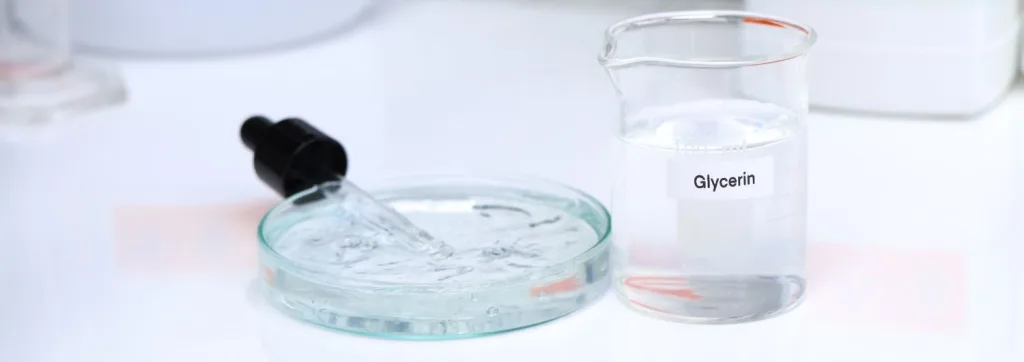
Used in several different manufacturing industries, glycerin, also known as glycerol, stands out as an ingredient that has multi-faceted purposes. It is a simple polyol that is able to attract moisture, making it highly useful in the formulation of products that hydrate and maintain moisture, from skincare lotions to pharmaceuticals and nutraceuticals. In addition, glycerin is non-toxic and soluble in both water and alcohol, so it also can be found in food, personal care, and certain industrial applications. With its role as a humectant, solvent, and sweetener, glycerin can enhance a product’s texture, preserve moisture, and extend shelf life; it is no wonder why it is considered a critical ingredient in the development and manufacture of many products and is quickly becoming a staple in nutraceutical production.
Glycerin is a sweet-tasting, viscous liquid that is colorless and odorless. It is a trihydroxy alcohol (C3H803) with three hydroxyl (OH) groups that make it highly hygroscopic, which means that it can attract and maintain moisture from the air. It also has a high boiling point at 290°C (554°F), and when frozen it becomes a paste, making it stable under a variety of conditions. Its compatibility with many substances and its safety for human consumption are other attributes that make glycerin a valuable ingredient across a wide range of industries.

The discovery of glycerin dates back to the late 18th century when it was first isolated from olive oil by Swedish chemist Carl Wilhelm Scheele. Initially, glycerin was a byproduct of soap manufacturing, obtained through the saponification process where fats and oils are reacted with an alkali. The industrial significance of glycerin heightened during the 19th century, notably for its uses in food, pharmaceuticals, and explosives (in the form of nitroglycerin).
Today, glycerin is produced through both natural and synthetic processes. The traditional method involves the hydrolysis of triglycerides found in natural fats and oils, which can be derived from both animal and vegetable sources. This splits the triglycerides into fatty acids and glycerol, after which the glycerol is purified. A more modern synthetic method involves the chemical synthesis of glycerol from propylene, a petroleum derivative. This method allows for the production of glycerin without relying on fats and oils, providing a synthetic alternative to naturally derived glycerol.
The glycerin available in today’s market can broadly be categorized into two types: vegetable and synthetic.
Both types of glycerin are invaluable in their respective applications, with the choice between them often dictated by the specific requirements of the product formulation, consumer preferences, and sustainability considerations.

As described before, glycerin’s characteristics allow it to be utilized across a variety of industries for many applications. In the growing field of nutraceuticals, glycerin is extensively applied due to its versatile properties and nontoxic nature.
With its moisture-retaining and texture-enhancing qualities, glycerin’s role is pivotal in the production of gummies and protein/nutrition bars. In gummies, glycerin prevents hardening and preserves the soft, chewy texture that consumers are looking for. Similarly in protein and nutrition bars, it helps maintain moistness and prevents the bars from becoming too dry or hard, enhancing the eating experience while extending shelf life.
Glycerin is a key ingredient in the production of softgel capsules, a popular form for dietary supplements. Its plasticizing properties make the gelatin shells soft and easy to swallow, improving the user experience. The presence of glycerin in these capsules helps maintain their integrity and flexibility over time, preventing them from drying out or becoming brittle. This ensures that the supplements remain potent and effective throughout their shelf life.
Many nutraceutical products rely on concentrated botanical extracts for their health benefits. Glycerin acts as an excellent solvent for these extracts, enabling the effective encapsulation of active ingredients derived from plants. Its mild and nontoxic nature makes it a preferable choice over alcohol-based solvents, particularly for products aimed at children or individuals avoiding alcohol for personal or health reasons.
Nutraceuticals often come in chewable forms or lozenges, especially for consumers who have difficulty swallowing pills. Glycerin’s humectant properties play a crucial role in these products, retaining moisture to ensure they stay soft and palatable. Additionally, glycerin can give a slight sweetness without contributing to the sugar content, making these products more appealing to a broad audience, including those monitoring their sugar intake.
The texture and consistency of liquid nutraceuticals, such as syrups and emulsions, are crucial for consumer acceptance and compliance. Glycerin can be used to adjust the viscosity of these products without altering their nutritional content. Its presence helps achieve a smooth, palatable texture that enhances the overall consumer experience, encouraging regular use as part of a health regimen.
Glycerin significantly contributes to the formulation and quality of nutraceutical products, addressing the growing consumer demand for health supplements that are effective, safe, and enjoyable to use.
Glycerin is recognized for its ability to enhance the efficiency and cost-effectiveness of production processes. Its role as a solvent, humectant, and plasticizer can significantly reduce the need for more expensive or less efficient additives, offering manufacturers a versatile ingredient that can perform multiple functions within a formulation. This multipurpose utility helps streamline production processes, reducing complexity and the potential for issues arising from the interaction of multiple additives. Moreover, glycerin’s effectiveness in small quantities can lead to lower overall production costs, contributing to more economically viable product lines and allowing companies to allocate resources more efficiently elsewhere.
Using glycerin into product formulations offers many benefits, including enhanced product stability, improved consumer experience, and extended shelf life. High-purity glycerin ensures consistent performance, enabling products to maintain their bioavailability and sensory attributes throughout their lifespan. This consistency contributes to product integrity and directly impacts consumer trust and brand reputation. The use of premium glycerin can also enhance the perceived value of products, supporting premium pricing strategies and reinforcing brand positioning as a leader in quality.

Glycerin is recognized for not only its functional benefits but also for its alignment with environmental and safety priorities in sustainable procurement practices. As a biodegradable and non-toxic substance, glycerin offers an eco-friendly alternative to synthetic and potentially harmful chemicals. The availability of vegetable-based glycerin supports the demand for renewable and sustainable resources, appealing to environmentally conscious consumers and companies aiming to reduce their carbon footprint.
Also, glycerin’s safety profile enhances workplace safety, minimizing the risk of accidents and health issues associated with the handling and processing of more hazardous materials. By prioritizing high-quality glycerin sourced from responsible suppliers, businesses can further their commitment to sustainability, safety, and ethical practices, attributes increasingly valued by consumers and stakeholders alike.
The market for glycerin is influenced by a combination of factors, including:

Understanding these market trends and supply chain dynamics is essential in effectively navigating the complexities of the glycerin market effectively. By staying informed and partnering with a reliable supplier, businesses can secure a competitive advantage, ensuring the consistent quality and supply of glycerin necessary for their operations.
Thanks to its unique attributes and versatile applications, glycerin can be integral to several manufacturers with different products. Its different roles in product formulations make it a critical contributor to product quality and stability as well as consumer satisfaction. Its application is beginning to extend into nutraceuticals, where it can enhance the delivery and efficacy of active ingredients.
When it comes to meeting evolving consumer demands and regulatory requirements, Vivion, as a wholesale supplier, is a strategic ally. With our commitment to quality and customer service, we stand at the ready to support and empower manufacturers so that they not only meet but exceed their goals. We strive to be your single source solution with our reliable glycerin supply and expert guidance from our knowledgeable team. Get in touch with us today to explore our high quality glycerin and other ingredients in our extensive product line.
https://www.matweb.com/search/datasheet.aspx?matguid=015b4c540c454ad7b944980dfa9438c8&ckck=1
https://www.britannica.com/science/glycerol
https://www.ams.usda.gov/sites/default/files/media/Glycerin%20Petition%20to%20remove%20TR%202013.pdf
https://www.sciencedirect.com/science/article/abs/pii/B9780323029988500184
https://www.ncbi.nlm.nih.gov/pmc/articles/PMC8231507/
https://www.medicines.org.uk/emc/product/6727/smpc#gref
https://www.verywellhealth.com/glycerin-7499424
https://www.researchgate.net/publication/308647639_Sustainable_Production_of_Glycerol